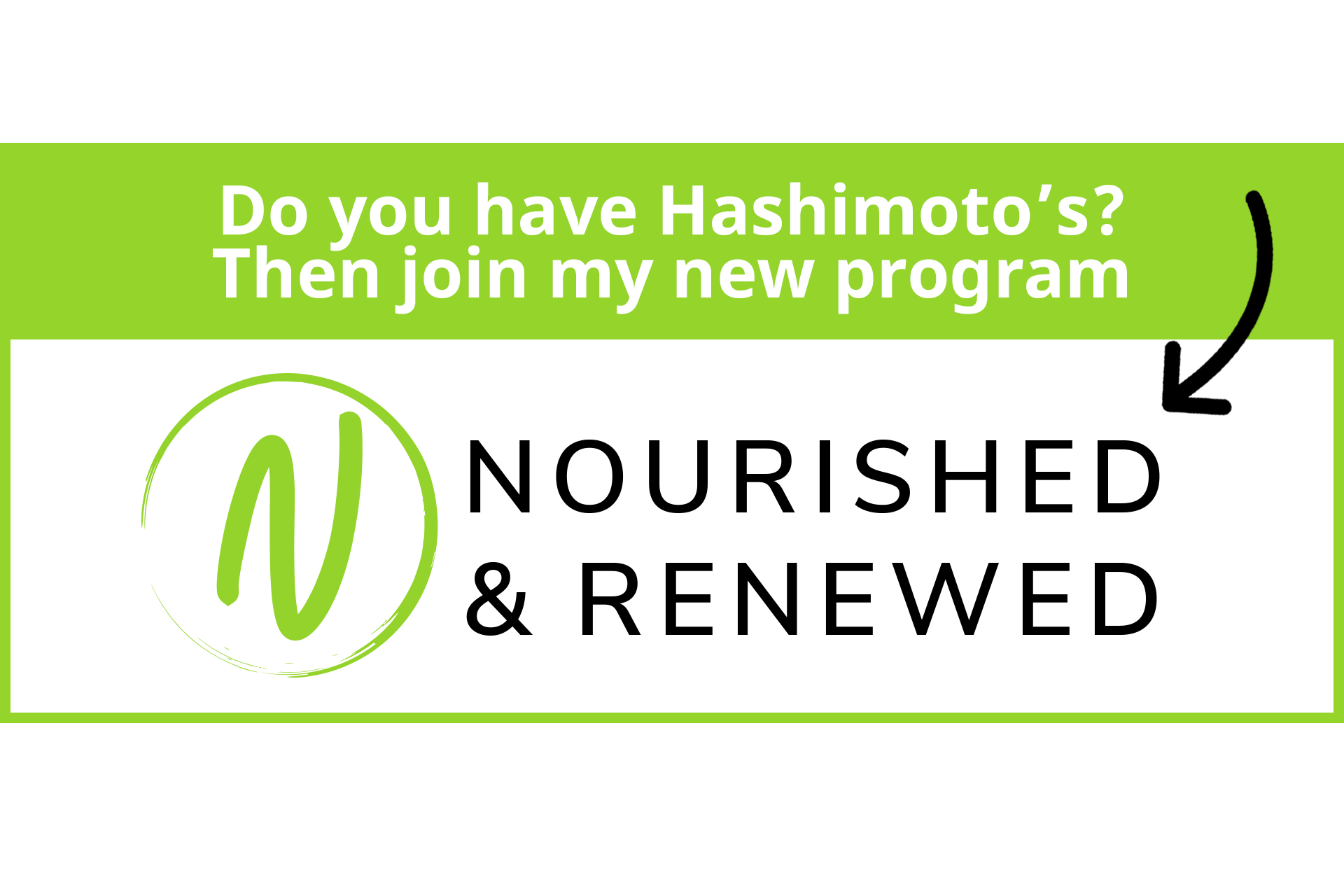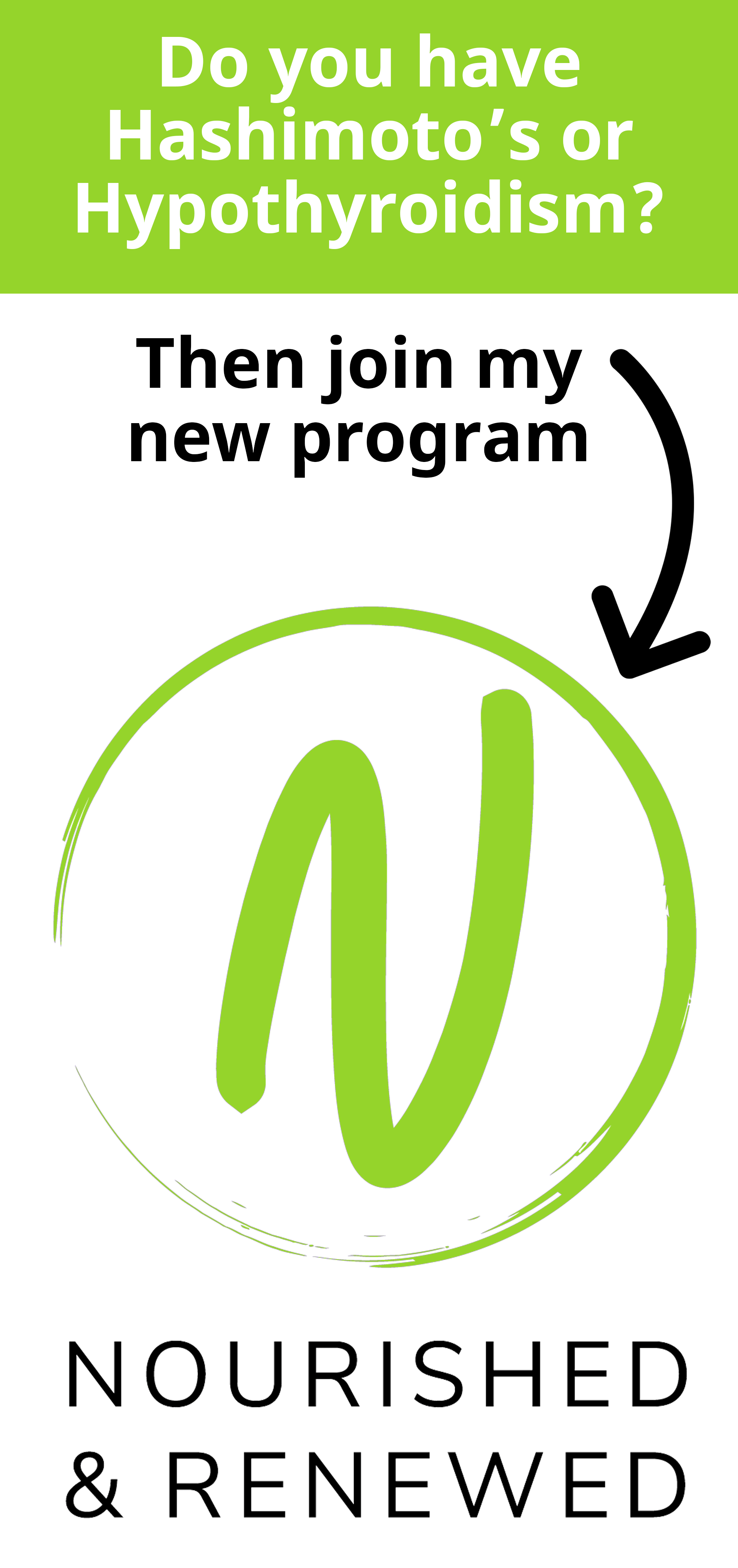Blood Sugar Struggles with Hashimoto’s
Living with, let alone thriving with, Hashimoto’s can be an ongoing struggle. But when you are additionally struggling with diabetes, it can be downright overwhelming.
It may feel like you got the short end of the stick but it is actually quite common to have blood sugar and thyroid issues at the same time, because of the strong link in thyroid function and blood sugar balancing.
The good news is that because they are linked in this way, positively affecting one often positively affects the other.
It may come as no surprise then, to learn that medication for one dysfunction can greatly aggravate the other as well.
While I myself do not have diabetes, I have learned from my own experience with Hashimoto’s that when something is out of balance with any component of my total thyroid health program, the first sign I recognize is reactive hypoglycemia.
More about that in a minute.
But the important point here is that with one or both of these conditions (Hashimoto’s or a blood sugar disorder), you can learn what is normal for your body.
Early warning signs of blood sugar dysregulation (which for me are feeling shaky, light-headed, irritable, extra hungry) are important to pay close attention to.
I have many clients with Hashimoto’s who never put it together that thyroid and blood sugar health are two sides of the same coin.
I hope this blog post helps you make sense of these important conditions, their interactions, and how nutrition can help.
Understanding Hashimoto’s Disease
Hashimoto’s Disease is an autoimmune disorder that causes the body to attack its own thyroid gland, despite the fact that it does so much and is required for so many vital functions in the body.
It is not completely understood why some people’s immune system may think the thyroid is an enemy but it appears to be on the rise.
The antibodies created during this attack lead to inflammation, tissue damage and disrupted thyroid function. Because of this, the thyroid becomes under-active, sometimes requiring medication for life.
Increased risk factors for Hashimoto’s include genetic influences and predispositions (such as the MTHFR mutation), exposure to environmental toxins, nutrient deficiencies, hormone imbalances and leaky gut (a term used to describe increased permeability of the lining of the gut).
People often show signs of thyroid dysfunction for years before finally getting a diagnosis but they may be told they are imagining symptoms to be worse than they are.
I have been through a lot on my own personal Hashimoto’s journey. Miscarriages, postpartum thyroiditis, and adrenal troubles have affected me at some point along the way.
My Hashimoto’s diagnosis was in 2003. I have no doubt that years of Irritable Bowel Syndrome (IBS) symptoms were at the root cause of my autoimmune thyroid disease.
I also have pretty clear memories from college and my early 20s when I was also experiencing wild and uncomfortable swings in my blood sugar.
No doctor at that time drew the conclusion that these symptoms might all be a part of the same syndrome.

Understanding Diabetes & Other Blood Sugar Disorders
How Does Blood Sugar Regulation Work?
Blood sugar regulation is the process by which the levels of blood sugar, primarily glucose, are maintained by the body within a narrow range.
This tight regulation is referred to as glucose homeostasis.
Glucose is absolutely essential for the running of our body, as it provides a source of energy for our muscles and fat cells to draw upon.
The body gets its supply of glucose from the food we eat and then absorb it into the bloodstream.
The bloodstream then transport it around the body to the many different cells where energy may be needed.

Insulin, which lowers blood sugar, and glucagon, which raises it, are the most well known of the hormones involved. Blood sugar levels are regulated by insulin and glucagon in order to keep the body in balance.
The levels of glucose in the blood are monitored by many tissues, but the cells in the pancreas are among the most well understood and important.
The amount of glucose in our blood is very important and our body keeps this under tight control. The reason for this is simple; both too much and too little glucose can be detrimental for the body.
Simply put, if the blood sugar is low, the pancreas releases glucagon. This helps the liver to turn stored sugar into glucose to increase blood sugar levels back to the normal range.
If the blood sugar is too high, the pancreas releases insulin. This helps the liver to store the excess sugar and the body to use the glucose already in the bloodstream for energy.
Blood Sugar Disorders
Diabetes
There are different kinds of diabetes, the most commonly known being Type I and Type II. While both of these concern problems balancing blood sugar through insulin, the root cause can be very different.
Diabetes Type I, which used to be called juvenile diabetes, is largely considered to be genetic. However, it can also be triggered by viruses or environmental factors.
Insulin, which the body needs to regulate blood sugar levels after food is consumed, is either not produced or produced in minimal amounts.
Diabetes Type II, which had previously been called adult-onset diabetes, can be caused by poor diet, genetics, weight gain or inactivity.
In this case, although the body creates insulin, it has also lost sensitivity to the hormone so that more and more is needed.
We no longer use the terms juvenile or adult-onset diabetes because Type II has been on the rise in children as poor diet has too often become the norm.

Other Types of Blood Sugar Disorders
Hypoglycemia is when your blood sugar levels get too low and you may experience headaches, shakiness, irritability or other symptoms. In most cases, eating can quickly make you feel better.
Some doctors consider you to hypoglycemic if your blood sugar tests below 70 mg/dL, but different doctors may look for different ranges.
Reactive hypoglycemia is slightly different in that you may become or stay hypoglycemic even after eating. It is thought this may be a result of the body secreting too much insulin.
When the body’s natural reaction to lower blood sugar from the secretion of insulin does not occur, it may be insulin resistance. Insulin resistance can lead to prediabetes and eventually diabetes Type II.
Women with polycystic ovarian syndrome (PCOS) are often insulin resistant.
Gestational diabetes is a term used for when a woman who had previously not been diabetic, becomes diabetic during pregnancy.
Most women are tested for this during their pregnancies and it can show up in the second trimester.
Although there are certainly some stark differences between these many forms of blood sugar disorders, the risk for any of them can increase with thyroid issues like Hashimoto’s.
Let’s look at why.

The Strong Links Between Thyroid and Blood Sugar
An early study that helped draw attention to this connection between the thyroid and blood sugar found that when the thyroid was removed, blood sugar levels dropped.
The 1927 study also looked at people who produced too much thyroid hormones (hyperthyroidism) and also had diabetes.
This particular study gives us a better understanding of the relationship between the thyroid hormones and the hormone insulin.
Another study in 1995 offered thyroid screenings for patients already diagnosed with diabetes . It found that women with Type I diabetes had the highest risk of thyroid disease.
But it also found that all the diabetes patients had a higher risk of thyroid disease than the general population.
These risks may stem from a number of things, one of which is that in cases of diabetes (both Type I and II), low T3 and free T3 levels have been found, while reverse T3 levels are elevated.
Here is what we must understand about this relationship: A key function of thyroid hormones is to regulate insulin secretion, sensitivity and responsiveness.
This means that in cases of hypothyroidism, such as Hashimoto’s, the ability for insulin to do its job decreases.
What Causes Blood Sugar Problems?
There are many factors that contribute to the risks of poor blood sugar regulation.
One of the biggest and perhaps most obvious is consuming a poor diet.
This happens because diets high in sugars and simple or processed carbohydrates lead to excess glucose in the blood, requiring more insulin.
As “sugary” foods are consumed with greater frequency, the body becomes resistant to the insulin, requiring more to be secreted.
But your food choices may not be the only factor.
High stress can increase your chance for blood sugar issues.
One of the ways in which this plays out is that hormones like adrenaline and cortisol are released during times of stress.
These hormones can cause an increase in both insulin and inflammation.
Stress can also lead the body to put blood sugar regulation on the back burner, allowing glucose levels to remain raised.
Smoking cigarettes increases your risk of Type II diabetes by 30-40%. This is because the nicotine itself is one of the reasons that risk goes up and vaping is not a good alternative.
Living a sedentary lifestyle also contributes to an increased risk for Diabetes. Lack of exercise would be the obvious lifestyle habit that could be improved upon.
But, interestingly, prolonged TV watching is associated with a significantly increased risk of type 2 diabetes.
Men who watch TV more than 40 hours per week have a nearly threefold increase in the risk of type 2 diabetes compared with those who spend less than 1 hour per week watching TV.

Thyroid and Blood Sugar Testing and Treatment
Looking at these will offer a first glimpse into how well your thyroid is functioning.
Another option is to test for thyroid antibodies. When these are elevated, it can be a sign that the immune system is attacking the thyroid itself, which is Hashimoto’s.
The most common way people find out they may have a blood sugar disorder is from a fasting blood sugar (FSB) test.
This can indicate your glucose levels when you haven’t eaten and also your levels of A1C, which is the amount of hemoglobin in your blood that has glucose attached.
Blood sugar levels 70-100mg/dL are considered healthy. But 110-125mg/dL is prediabetes, while anything above may give you a diabetes diagnosis.
For a gestational diabetes diagnosis, doctors may start with the FSB test but will often also give another test after consuming a high-carbohydrate drink.
At that point, a diagnosis may be given if results are higher than 180mg/dL after one hour or 153mg/dL after two hours.
Additional tests may be required to know specifically if insulin resistance is an issue.
In my nutrition practice, I utilize the Spectracell micronutrient test to assess any possible deficiencies that may be contributing to blood sugar disorders.

A Balancing Act For Healthy Blood Sugar (especially if you have thyroid problems!)
Whether you have been diagnosed with a form of diabetes or not, balancing blood sugar is vital for overall health to maintain a healthy weight, preventing heart disease and so much more.
I talk about the importance of balancing blood sugar for optimal health A LOT!
My clients can vouch for this! But, hey, it’s for a good reason.
Why? Because blood sugar stability is so fundamental to how we feel. Blood sugar stability is fundamental to good health and without it we can’t be truly healthy.
So, when we understand the concept of eating for blood sugar stability, and start to make changes to the way we eat, and drink, we feel SO much better.
However, if you have received a diagnosis of Hashimoto’s, or any other thyroid condition, the balancing act for your blood sugar becomes all the more important because of the increased diabetes risk.
Alternately, if you are known to have diabetes and regulate it well, it may be time to get a thyroid panel if you continue to have problems such as:
- Fatigue
- Weight gain
- Often feeling cold
- Joint stiffness or pain
- Constipation
- Depression
- Thinning or loss of hair
- Heavy or irregular periods
- Memory or focus problems
- Low heart rate
These are common symptoms of Hashimoto’s, which is under diagnosed, especially compared to diabetes.

The Medication Factor For Hashimoto’s and Diabetes
Medications for both diabetes and thyroid disorders can be life-changing for some people. But there are side effects and risk factors involved in some as well that could exacerbate conditions.
The drug Metformin, often used in cases of diabetes Type II, has been found to increase the risk of lower levels of thyroid-stimulating hormone (TSH).
You can imagine that if you already have Hashimoto’s, this could be devastating. Or if you don’t but are at risk, this could certainly push you in that direction.
The other side of the coin is that thyroid medications may have an effect on blood sugar and therefore diabetes risk as well.
Synthroid, one of the most common thyroid medications, is known to raise blood sugar levels.
Armour Thyroid, another widely used medication, also warns on the prescription label that it is important to try to maintain blood sugar levels, due to the medication’s side effects.
Always speak with your doctor if you have questions about medications and their complications.
And never stop taking any medications without talking to your doctor.
Can Food Be a Solution To Support Your Thyroid and Balance Your Blood Sugar?
One thing many of my clients have shared with me is that when they received their diagnosis of either or both Hashimoto’s and/or Diabetes, doctors didn’t explain to them the relationship between foods they are eating and how they are feeling!
It is unfortunate that, many times, nutrition is overlooked as a primary healing tool.
The path to surviving and thriving with both Hashimoto’s and diabetes can have many forks (so to speak) but food can certainly be a big part of that path.
There are many foods that both help balance blood sugar and also support thyroid health.
And as you can imagine, there are also foods that are better to avoid with that double diagnosis.
Food Quality Effect on Blood Sugar Levels
Generally, the more a food is processed, the worse it is for general health and certainly for blood sugar. That is because processing removes vital nutrients and fiber that help slow blood sugar spikes.
Avoid processed, packaged, sugary or high-carbohydrate foods as much as possible.
Pesticides, herbicides and genetically modified organisms (GMOs) create toxicity and inflammation in the body. This adds to any existing inflammation in the thyroid and the gut.
And since insulin is a hormone and the thyroid secretes its own hormones, adding to the mix more hormones that can be found in meats (like those that are not organic), throws hormonal balances off throughout the body.
It is best to consume meats, animal fats and dairy that contain no added hormones at any time during the animal’s life.

Protein does not affect blood sugar
Protein is an essential macronutrient that is key for thyroid and blood sugar. The amino acids that make up protein help support glands throughout the body, including the thyroid, and aid in repairing any damage to those glands.
Thyroid hormones need protein as a transporter throughout the body.
Protein also has no effect on blood sugar.
It does not require insulin as part of its processing and digesting, making it a perfect and crucial inclusion in your diet. Some great options include:
- Grass-fed or pastured meats
- Wild caught fatty fish
- Pastured eggs
Fiber helps to slow down blood sugar spikes
Another great thing to include is plenty of fiber-rich foods that help with gut and colon health, slowing blood sugar spikes and heart health:
- Ground flax seeds (should be stored in the freezer to protect their fragile fats)
- Chia seeds
- Other seeds and nuts
- Chickpeas and lentils
- Sweet potatoes
- Dark leafy greens (collard and turnip especially)
There are a great variety of fruits and vegetables that naturally support the body’s digestion efforts and enhance the detoxifying process, making them a great addition to any Hashimoto’s/diabetes diet:
- Apples
- Beets
- Carrots
- Garlic and ginger
- Milk thistle
- Aloe vera
- Turmeric (especially fresh, as opposed to dried)
Cinnamon reduces inflammation
One of the biggest diabetes powerhouses is cinnamon. This sweet, warming and delicious spice has been found in multiple studies to improve insulin sensitivity.
Cinnamon also reduces inflammation and has been found to lower cholesterol levels.
It can also be used as a supplement.
Ideally you could include it in the diet, added to both sweet and savory foods like oatmeal, in a meat rub or marinade, tea or coffee, apples, curries, mole sauce, squashes and other vegetables.
Water helps flush excess glucose out of the body
First and foremost, water is a replacement for juices and sodas. We can ignore water for its role in our health, including blood sugar and thyroid health.
Water won’t negatively affect blood glucose levels and it will help flush excess glucose out of the body through urination.
Diabetes increases the risk of dehydration and drinking water helps hydrate the blood.
Staying hydrated can also support some of the symptoms of Hashimoto’s, including fatigue and constipation.
In fact, healthy and regular bowel movements are essential in cases of both Hashimoto’s and diabetes and water may be the single biggest supporter of happy poops.
Nutrients to Support Your Thyroid and Healthy Blood Sugar Regulation
Vitamins and minerals (what we call micronutrients) are essential in keeping our glands and organs functioning optimally. Whether just from food or from food and supplements, these nutrients encourage thyroid and blood sugar health:
- Magnesium - works with enzymes on the body to control and metabolize glucose. It also helps convert the inactive T4 form of thyroid hormone into the active T3 form; found in dark, leafy greens.
- Chromium - increases insulin sensitivity. Certain forms of supplemented chromium can inhibit thyroid medications so check with you doctor before supplementing or, even better, get it from food like broccoli, tomatoes and green beans.
- Zinc - zinc supplementation has been found to decrease diabetes risk. People with blood sugar imbalances had lower levels of zinc in the blood, needed for the body to create thyroid hormones; found in oysters and shrimp, mushrooms and red meat.
- Selenium - too much selenium from supplementation can increase diabetes risk. It is better to obtain selenium from food, helps to convert inactive T4 hormones to active T3 hormones and works with iodine to support the thyroid; found in fish, mushrooms and asparagus
Hashimoto’s and Diabetes, Where to Go From Here
Getting two separate diagnoses, or even suspecting you have two, can feel like so much to take on. But if you approach diabetes and Hashimoto’s like two branches of the same tree, I believe it feels much more approachable.
One affects the other synergistically, which allows dietary and lifestyle changes to ripple out to both disorders. It means you can make a bigger impact.
This is true of many glandular disorders because of how hormones work throughout the body and affect other hormones.
Even if you are not diabetic, knowing about this relationship and the higher risk can give you motivation to make healthy choices to avoid blood sugar imbalance.
If you are feeling overwhelmed with a double diagnosis, or suspect a second disorder, please speak to your physician right away about obtaining more information on medical treatment.
Figuring out the nutrition component of treatment for these disorders can also be challenging. Starting with the information in this article is a great first step.
If you want to go a step further beyond balancing your blood sugar and restoring your thyroid health, my 30-day Nourished and Renewed with Hashimoto's Program provides the necessary tools and resources all in one place for you to set off on your healing journey.
If you are in need of additional guidance, support and a customized nutrition plan, the Happy & Healthy Adult Program is definitely for you. I developed this program after my own years of research and applying these principles to myself.
So many of my clients have discovered that the Happy & Healthy Adult Program truly addresses the root cause of both thyroid conditions and blood sugar disorders.
A holistic nutrition approach to balancing your blood sugar, and ultimately, achieving optimal health for your thyroid, is the absolute best way to go.
Are you ready? Let’s talk!






